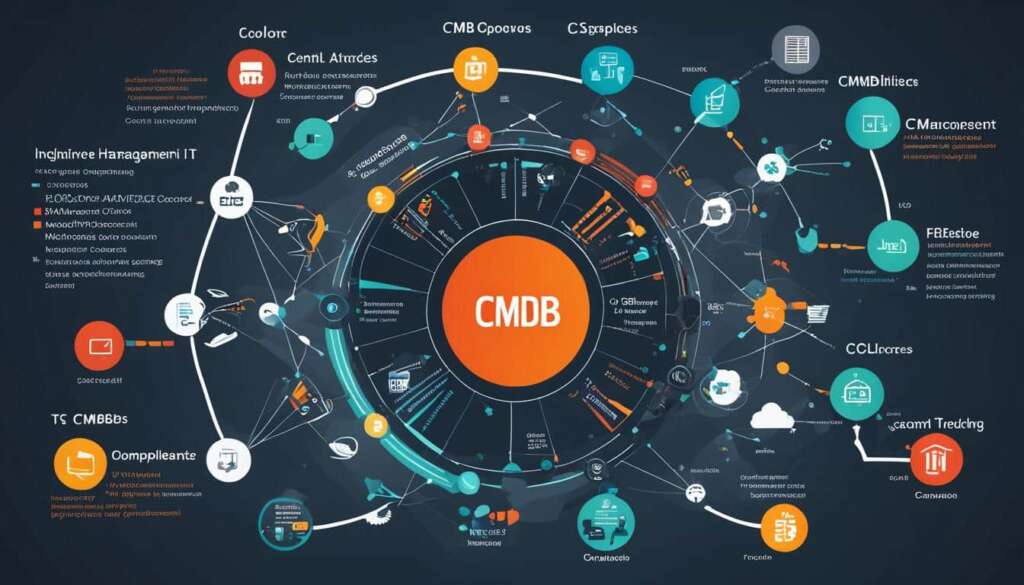Table of Contents
Welcome to our comprehensive guide on the Configuration Management Database (CMDB) and its crucial role in IT management. In today’s fast-paced digital landscape, businesses rely heavily on their IT infrastructure to streamline operations and drive organizational efficiency. A CMDB is the key to effectively managing and optimizing IT assets, ensuring smooth functioning and maximizing productivity.
But what exactly is a CMDB? How does it work, and who can benefit from it? In this article, we will dive deep into the world of CMDBs, exploring their definition, functionality, benefits, and challenges. We’ll also discuss their evolution in alignment with IT service management practices.
But before we delve into the details, let’s take a moment to understand the significance of CMDBs in streamlining IT asset management, improving organizational efficiency, and optimizing decision-making processes.
Now, let’s embark on a journey of discovery as we unravel the intricacies of CMDBs, empowering you with the knowledge to transform your IT management practices.
What is a CMDB?
A configuration management database (CMDB) is a file or database that stores all relevant information about the hardware and software components used in an organization’s IT services and the relationships among them. It provides an organized view of configuration data, allowing IT teams to examine and manage that data from different perspectives.
CIs, or configuration items, are the components in an information system that can be tracked within a CMDB. These components can include software, hardware, documentation, and personnel. CMDBs capture attributes of CIs, such as ownership, identification code, and importance, and provide details about relationships and dependencies between CIs.
| Components | Attributes | Relationships |
|---|---|---|
| Software | Ownership, identification code, importance | Dependencies with other software components |
| Hardware | Ownership, identification code, importance | Dependencies with other hardware components |
| Documentation | Ownership, identification code, importance | Relationships with other documentation |
| Personnel | Ownership, identification code, importance | Relationships with other personnel |
Benefits of a CMDB
Implementing a CMDB brings various benefits to organizations. It improves visibility into the IT infrastructure, providing IT administrators with a centralized view of components and better control. A CMDB enables easier identification of potential problems and ensures faster issue resolution. It also aids in compliance with regulations and standards, improves communication between teams, and enhances documentation of changes. By automating the documentation process, a CMDB helps save time and money, while improving the quality of data and information.
How does a CMDB work?
A robust CMDB solution automatically populates with data from various sources, including discovery tools and system logs. This data is used by IT specialists to create a comprehensive view of the IT infrastructure, including changes over time and potential problems.
“A CMDB provides a single source of truth for IT teams to track and understand their IT environment,” says Mark Johnson, an IT specialist at ABC Corporation. “By consolidating data from different sources, the CMDB enables us to have a holistic view of our IT assets and their relationships, improving our ability to manage and make informed decisions.”
For example, when a server is added to the network, a CMDB can automatically update its documentation and add it to the inventory. This automation eliminates the need for manual entry and reduces the chances of errors or missing information.
A CMDB streamlines asset management by centralizing information about IT assets, such as servers, applications, databases, and network devices. With a CMDB, IT teams can easily access detailed documentation, including specifications, configurations, and associated support contracts. This documentation enables faster troubleshooting and better decision-making.

Improved visibility into the IT infrastructure is another significant benefit of a CMDB. By capturing and organizing data about the IT assets and their relationships, a CMDB provides a clear picture of the dependencies between different components. This visibility helps IT teams understand how changes to one component may impact others, allowing them to plan and execute changes more effectively.
Furthermore, a CMDB facilitates better communication between teams involved in IT management, such as infrastructure, applications, and security teams. By providing a centralized repository of IT asset information, the CMDB ensures that all teams have access to accurate and up-to-date information. This encourages collaboration and reduces time wasted on searching for data across multiple systems.
In addition to streamlining asset management and improving visibility, a CMDB also plays a crucial role in ensuring compliance with regulations and standards. By documenting and tracking IT assets, a CMDB helps organizations demonstrate adherence to security, privacy, and audit requirements.
“Having a CMDB has significantly enhanced our ability to meet compliance obligations,” says Lisa Thompson, the IT compliance manager at XYZ Enterprises. “We can easily generate reports and provide evidence of our IT asset management practices, which has saved us a considerable amount of time and effort during audits.”
Summary:
A CMDB works by automatically populating with data from various sources, such as discovery tools and system logs. It streamlines asset management, improves visibility into the IT infrastructure, facilitates communication between teams, and ensures compliance with regulations and standards. With a CMDB, IT teams can easily track and understand their IT environment, make informed decisions, and resolve issues more efficiently.
Who needs a CMDB?
IT organizations, regardless of size or industry, can benefit from implementing a Configuration Management Database (CMDB). A CMDB allows IT teams to capture and track information about configuration items (CIs) within their IT infrastructure, enabling better management and improvement.
Paired with asset management systems, CMDBs help identify and verify all components within the IT infrastructure, ensuring accurate inventory and better control. By leveraging CMDB data, IT administrators can predict and understand how changes can affect IT systems, enabling them to proactively plan for necessary updates and replacements.
A CMDB provides a centralized view of data, leading to improved control, cost savings, and seamless data integration. It enables IT organizations to make well-informed decisions and streamline their IT processes. With a CMDB in place, IT teams can easily access and analyze CI data, facilitating efficient asset management and ensuring the smooth operation of IT systems.
| Benefits of a CMDB for IT Organizations: |
|---|
| Improved Asset Management: A CMDB helps identify and track all IT components within the organization, ensuring accurate inventory and efficient asset management. |
| Better Decision-Making: By leveraging CMDB data, IT organizations can gain insights into how changes can impact IT systems, enabling informed decision-making and proactive planning for updates and replacements. |
| Centralized Data View: A CMDB provides a centralized view of data, allowing IT teams to easily access and analyze CI data, leading to improved control, cost savings, and data integration. |
| Streamlined IT Processes: With a CMDB, IT organizations can streamline their IT processes and improve operational efficiency, resulting in better service delivery and customer satisfaction. |
Implementing a CMDB empowers IT organizations to have a comprehensive understanding of their IT infrastructure, enabling them to efficiently manage assets, mitigate risks, and optimize the performance of their IT systems.
Quote:
“A CMDB provides IT organizations with a holistic view of their IT infrastructure, helping them make informed decisions and achieve operational excellence.”
Benefits of a CMDB
Implementing a CMDB brings various benefits to organizations. It improves visibility into the IT infrastructure, providing IT administrators with a centralized view of components and better control. A CMDB enables easier identification of potential problems and ensures faster issue resolution. It also aids in compliance with regulations and standards, improves communication between teams, and enhances documentation of changes. By automating the documentation process, a CMDB helps save time and money, while improving the quality of data and information.
Improved Visibility
A CMDB improves visibility into the IT infrastructure by consolidating data from various sources. IT administrators can have a centralized view of components, relationships, and dependencies. This ensures a comprehensive understanding of the IT environment, enabling better decision-making and resource allocation.
Problem Identification
With a CMDB, potential problems can be easily identified. By monitoring and tracking configuration items, IT teams can proactively identify issues and assess their impact on the IT infrastructure. This allows for timely intervention, reducing the risk of system failures and minimizing downtime.
Faster Issue Resolution
A CMDB streamlines the process of issue resolution. By having a clear overview of the IT infrastructure and its dependencies, IT administrators can quickly identify and address the root cause of issues. This results in faster resolution times, minimizing the impact on business operations.
Compliance
Compliance with regulations and standards is essential for organizations across various industries. A CMDB plays a crucial role in ensuring compliance by providing accurate and up-to-date information about IT assets and their configurations. This helps organizations meet regulatory requirements and pass audits with ease.
Communication
A CMDB enhances communication and collaboration between IT teams. With a centralized repository of information, teams can easily share and access relevant data. This improves coordination, facilitates knowledge sharing, and enables efficient problem-solving.
Documentation
Effective documentation is essential for managing the IT infrastructure. A CMDB automates the documentation process, capturing changes, updates, and configurations in real time. This ensures an accurate and comprehensive record, making it easier to track changes, analyze trends, and plan for the future.
Challenges of a CMDB
Implementing and maintaining a CMDB can pose several challenges for organizations. One key challenge is convincing businesses of the benefits of a CMDB and ensuring proper usage once implemented. Importing relevant data can be tedious and time-consuming as administrators need to input a wealth of information about each IT asset. Regularly updating and maintaining CMDB data is crucial to avoid data becoming stale and unusable. Data integrity is of utmost importance to ensure the CMDB remains accurate and reliable.
Evolution of CMDB
CMDBs have evolved over time, adapting to meet the changing needs of IT service management (ITSM) and reporting capabilities. Today, they play a central role in tracking and understanding the resources of an organization’s IT infrastructure. CMDBs now integrate seamlessly with IT asset management (ITAM) platforms, enabling a comprehensive view of the IT environment.
The importance of configuration management has grown significantly with the rise of software-based configurations and interactions. CMDBs have become essential in tracking configuration changes across both physical and digital assets, ensuring accurate documentation and enhancing governance.
The rise of DevOps practices and technologies, including containers, microservices, and automation, has expanded the scope of CMDBs. They now provide valuable insights into the dynamic and rapidly changing IT landscape. CMDBs have also aligned with ITIL specifications, putting a strong emphasis on discovery, security, reporting, and auditing.
Integration with other configuration-related processes, such as change management and incident management, further boosts the effectiveness of CMDBs in managing the entire IT environment. As organizations continue to adopt cloud technologies, CMDBs will play a crucial role in ensuring visibility, control, and compliance.
FAQ
What is a CMDB?
A CMDB, or configuration management database, is a file or database that stores all relevant information about the hardware and software components used in an organization’s IT services and the relationships among them.
How does a CMDB work?
A CMDB works by automatically populating with data from various sources, such as discovery tools and system logs. This data is used by IT specialists to create a comprehensive view of the IT infrastructure, including changes over time and potential problems.
Who needs a CMDB?
CMDBs are beneficial for all IT organizations, regardless of size or industry. They allow IT teams to capture and track information about configuration items (CIs) within their IT infrastructure, ensuring better management and improvement.
What are the benefits of a CMDB?
Implementing a CMDB brings various benefits to organizations. It improves visibility into the IT infrastructure, provides better control over components, aids in problem identification and faster issue resolution, ensures compliance with regulations and standards, improves communication between teams, and enhances documentation of changes.
What are the challenges of a CMDB?
Implementing and maintaining a CMDB can pose several challenges for organizations. These include convincing businesses of the benefits of a CMDB, importing relevant data, regularly updating and maintaining CMDB data, and ensuring data integrity.
How has the CMDB evolved?
CMDBs have evolved over time to align more closely with IT service management (ITSM) and reporting capabilities. They now integrate with IT asset management (ITAM) platforms and play a central role in tracking and understanding IT infrastructure resources.













